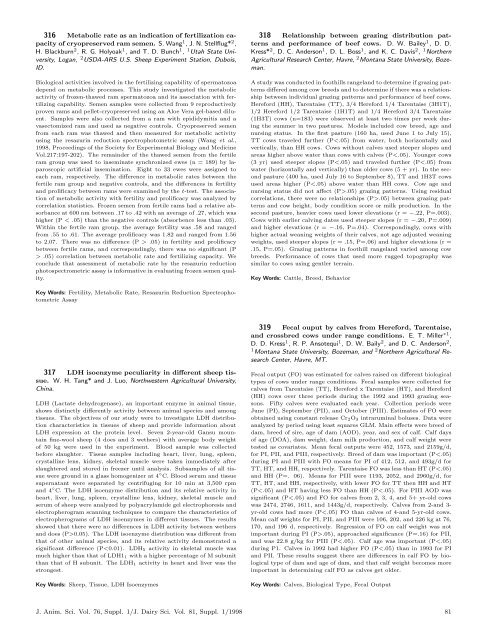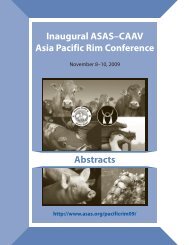BREEDING AND GENETICS - American Society of Animal Science
BREEDING AND GENETICS - American Society of Animal Science
BREEDING AND GENETICS - American Society of Animal Science
You also want an ePaper? Increase the reach of your titles
YUMPU automatically turns print PDFs into web optimized ePapers that Google loves.
316 Metabolic rate as an indication <strong>of</strong> fertilization capacity<br />
<strong>of</strong> cryopreserved ram semen. S. Wang 1 , J. N. Stellflug* 2 ,<br />
H. Blackburn 2 ,R.G.Holyoak 1 , and T. D. Bunch 1 , 1 Utah State University,<br />
Logan, 2 USDA-ARS U.S. Sheep Experiment Station, Dubois,<br />
ID.<br />
Biological activities involved in the fertilizing capability <strong>of</strong> spermatozoa<br />
depend on metabolic processes. This study investigated the metabolic<br />
activity <strong>of</strong> frozen-thawed ram spermatozoa and its association with fertilizing<br />
capability. Semen samples were collected from 9 reproductively<br />
proven rams and pellet-cryopreserved using an Aloe Vera gel-based diluent.<br />
Samples were also collected from a ram with epididymitis and a<br />
vasectomized ram and used as negative controls. Cryopreserved semen<br />
from each ram was thawed and then measured for metabolic activity<br />
using the resazurin reduction spectrophotometric assay (Wang et al.,<br />
1998, Proceedings <strong>of</strong> the <strong>Society</strong> for Experimental Biology and Medicine<br />
Vol.217:197-202). The remainder <strong>of</strong> the thawed semen from the fertile<br />
ram group was used to inseminate synchronized ewes (n = 189) by laparoscopic<br />
artificial insemination. Eight to 33 ewes were assigned to<br />
each ram, respectively. The difference in metabolic rates between the<br />
fertile ram group and negative controls, and the differences in fertility<br />
and prolificacy between rams were examined by the t-test. The association<br />
<strong>of</strong> metabolic activity with fertility and prolificacy was analyzed by<br />
correlation statistics. Frozen semen from fertile rams had a relative absorbance<br />
at 600 nm between .17 to .42 with an average <strong>of</strong> .27, which was<br />
higher (P < .05) than the negative controls (absorbence less than .03).<br />
Within the fertile ram group, the average fertility was .58 and ranged<br />
from .55 to .61. The average prolificacy was 1.82 and ranged from 1.56<br />
to 2.07. There was no difference (P > .05) in fertility and prolificacy<br />
between fertile rams, and correspondingly, there was no significant (P<br />
> .05) correlation between metabolic rate and fertilizing capacity. We<br />
conclude that assessment <strong>of</strong> metabolic rate by the resazurin reduction<br />
photospectrometric assay is informative in evaluating frozen semen quality.<br />
318 Relationship between grazing distribution patterns<br />
and performance <strong>of</strong> beef cows. D. W. Bailey 1 , D. D.<br />
Kress* 2 , D. C. Anderson 1 , D. L. Boss 1 , and K. C. Davis 2 , 1 Northern<br />
Agricultural Research Center, Havre, 2 Montana State University, Bozeman.<br />
A study was conducted in foothills rangeland to determine if grazing patterns<br />
differed among cow breeds and to determine if there was a relationship<br />
between individual grazing patterns and performance <strong>of</strong> beef cows.<br />
Hereford (HH), Tarentaise (TT), 3/4 Hereford 1/4 Tarentaise (3H1T),<br />
1/2 Hereford 1/2 Tarentaise (1H1T) and 1/4 Hereford 3/4 Tarentaise<br />
(1H3T) cows (n=183) were observed at least two times per week during<br />
the summer in two pastures. Models included cow breed, age and<br />
nursing status. In the first pasture (160 ha, used June 1 to July 15),<br />
TT cows traveled further (P
















